Results
-
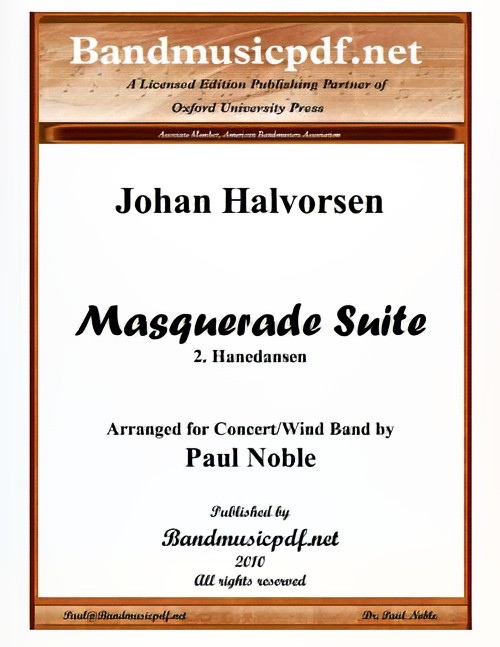 £75.00
£75.00Hanedansen (from Masquerade Suite) (Concert Band - Score and Parts) - Halvorsen, Johan - Noble, Paul
Masquerade Suite was composed by Johan Halvorsen, one of the best-kept secrets of Norway. Not only was he an accomplished violinist and conductor, but also he was among the most prominent Norwegian composers in the generation following Edvard Grieg. His compositions develop the national Romantic tradition of his friends Grieg and Svendsen, but his was a distinctive style marked by brilliant orchestration inspired by the French Romantic composers. The original version of Masquerade Suite had nine movements. Paul Noble has selected five of the most suitable movements for band transcription and grouped them into this beautiful suite. The U.S. Navy Band in Washington, D.C. gave the premiere performance of this work. The first movement, Holberg Overture, sets the mood, pace, and musical themes for the entire suite, with rousing opening themes, followed by a grand fugue in the development section. This is clearly a piece for accomplished bands, giving all wind players a real workout. Each of the succeeding movements has a distinctive style, making the suite a significant addition to the repertoire of the Concert Band. Especially noteworthy is the Arietta, the easiest of the movements, and can easily stand alone with its haunting flute and oboe melodies and dramatic crescendo, the crisp solos in the Molinasque, and the final movement, which is very much like a circus march, fast, lively and short!
Estimated dispatch 7-14 working days
-
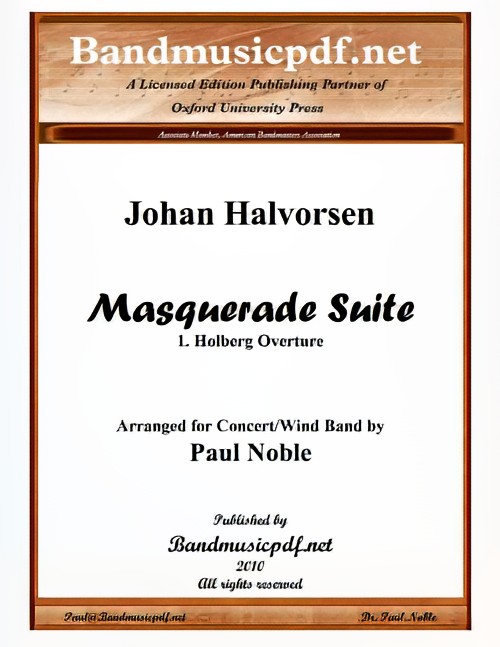 £75.00
£75.00Holberg Overture (from Masquerade Suite) (Concert Band - Score and Parts) - Halvorsen, Johan - Noble, Paul
Masquerade Suite was composed by Johan Halvorsen, one of the best-kept secrets of Norway. Not only was he an accomplished violinist and conductor, but also he was among the most prominent Norwegian composers in the generation following Edvard Grieg. His compositions develop the national Romantic tradition of his friends Grieg and Svendsen, but his was a distinctive style marked by brilliant orchestration inspired by the French Romantic composers. The original version of Masquerade Suite had nine movements. Paul Noble has selected five of the most suitable movements for band transcription and grouped them into this beautiful suite. The U.S. Navy Band in Washington, D.C. gave the premiere performance of this work. The first movement, Holberg Overture, sets the mood, pace, and musical themes for the entire suite, with rousing opening themes, followed by a grand fugue in the development section. This is clearly a piece for accomplished bands, giving all wind players a real workout. Each of the succeeding movements has a distinctive style, making the suite a significant addition to the repertoire of the Concert Band. Especially noteworthy is the Arietta, the easiest of the movements, and can easily stand alone with its haunting flute and oboe melodies and dramatic crescendo, the crisp solos in the Molinasque, and the final movement, which is very much like a circus march, fast, lively and short!
Estimated dispatch 7-14 working days
-
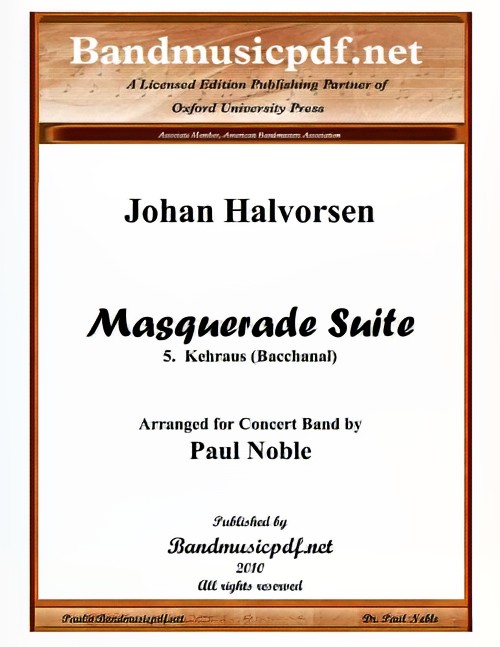 £65.00
£65.00Kehraus (from Masquerade Suite) (Concert Band - Score and Parts) - Halvorsen, Johan - Noble, Paul
Masquerade Suite was composed by Johan Halvorsen, one of the best-kept secrets of Norway. Not only was he an accomplished violinist and conductor, but also he was among the most prominent Norwegian composers in the generation following Edvard Grieg. His compositions develop the national Romantic tradition of his friends Grieg and Svendsen, but his was a distinctive style marked by brilliant orchestration inspired by the French Romantic composers. The original version of Masquerade Suite had nine movements. Paul Noble has selected five of the most suitable movements for band transcription and grouped them into this beautiful suite. The U.S. Navy Band in Washington, D.C. gave the premiere performance of this work. The first movement, Holberg Overture, sets the mood, pace, and musical themes for the entire suite, with rousing opening themes, followed by a grand fugue in the development section. This is clearly a piece for accomplished bands, giving all wind players a real workout. Each of the succeeding movements has a distinctive style, making the suite a significant addition to the repertoire of the Concert Band. Especially noteworthy is the Arietta, the easiest of the movements, and can easily stand alone with its haunting flute and oboe melodies and dramatic crescendo, the crisp solos in the Molinasque, and the final movement, which is very much like a circus march, fast, lively and short!
Estimated dispatch 7-14 working days
-
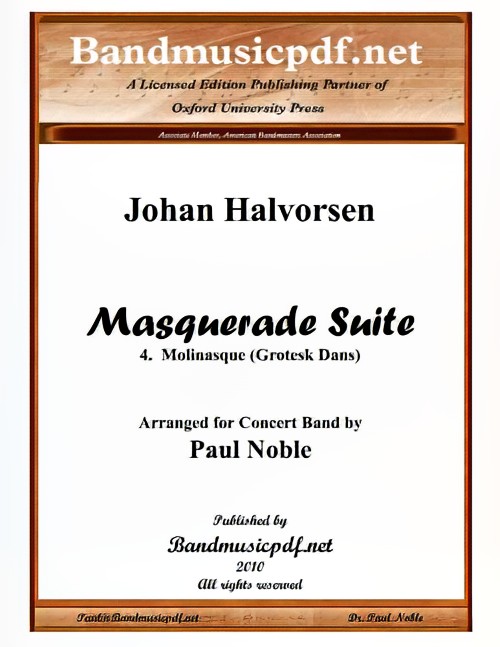 £75.00
£75.00Molinasque (from Masquerade Suite) (Concert Band - Score and Parts) - Halvorsen, Johan - Noble, Paul
Masquerade Suite was composed by Johan Halvorsen, one of the best-kept secrets of Norway. Not only was he an accomplished violinist and conductor, but also he was among the most prominent Norwegian composers in the generation following Edvard Grieg. His compositions develop the national Romantic tradition of his friends Grieg and Svendsen, but his was a distinctive style marked by brilliant orchestration inspired by the French Romantic composers. The original version of Masquerade Suite had nine movements. Paul Noble has selected five of the most suitable movements for band transcription and grouped them into this beautiful suite. The U.S. Navy Band in Washington, D.C. gave the premiere performance of this work. The first movement, Holberg Overture, sets the mood, pace, and musical themes for the entire suite, with rousing opening themes, followed by a grand fugue in the development section. This is clearly a piece for accomplished bands, giving all wind players a real workout. Each of the succeeding movements has a distinctive style, making the suite a significant addition to the repertoire of the Concert Band. Especially noteworthy is the Arietta, the easiest of the movements, and can easily stand alone with its haunting flute and oboe melodies and dramatic crescendo, the crisp solos in the Molinasque, and the final movement, which is very much like a circus march, fast, lively and short!
Estimated dispatch 7-14 working days
-
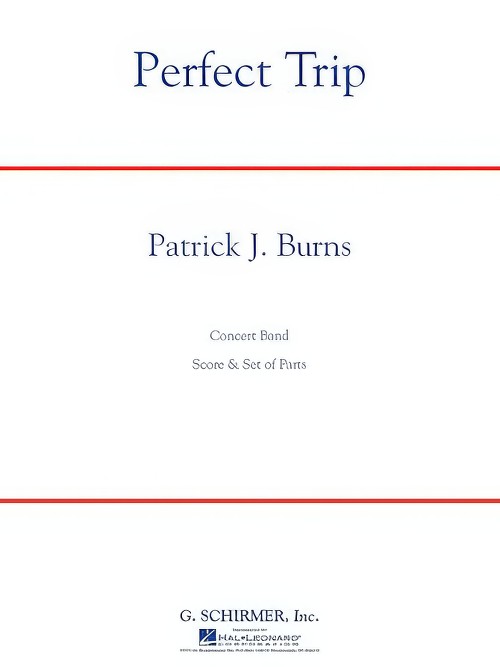 £57.50
£57.50Perfect Trip (Concert Band - Score and Parts) - Burns, Patrick J.
Perfect Trip derives its title from the horse racing term which refers to the flawless performance of a winning steed. It was written for the 20th anniversary concert of the Ridgewood Concert Band in New Jersey at the request of the band's founding director, Dr. C. Christian Wilhjelm. The piece itself lasts not much more than a typical one mile horse race and depicts the event from the observer's perspective: the initial burst of energy at the starting gate and the ensuing excitement approaching the first turn, the suspense as the race develops along the far stretch, and the increasing drama as the pack rounds the final turn and heads down the stretch for the big finish.
Estimated dispatch 7-14 working days
-
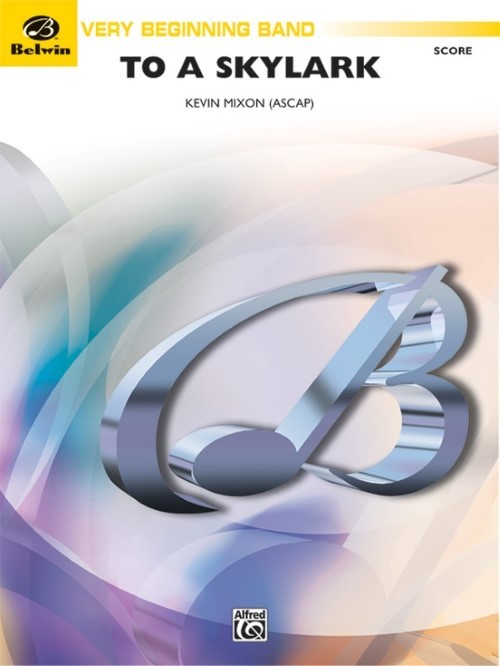 £50.50
£50.50To a Skylark (Concert Band - Score and Parts) - Mixon, Kevin
This rousing tune is filled with non-stop energy... and uses the only first five notes introduced in most method books (concert B-flat, C, D, E-flat, and F). Inspired by Shelley's famous poem of the same name, this energetic piece presents several opportunities for cross-curricular teaching. To a Skylark, is quality band music that beginning students will love! Duration: 1.30
Estimated dispatch 7-14 working days
-
 £67.32
£67.32The Gateway City
Marking 100 years since the first published music of the great American composer, bandmaster, and classic concert band proponent Karl L. King, C. L. Barnhouse is honored to launch the "Karl L. King Centennial Series" of new editions of King music. King's wonderful "The Gateway City March" inaugurates this new series with a flourish! In addition to full score, carefully edited parts, added stylistic practices, dynamics and articulations, this handsome new edition includes extensive information on the composer, this march, history, and performance practices of the "King-style." Long live the KING!
Estimated dispatch 7-14 working days
-
 £119.20
£119.20Sinfonisches Prludium - Anton Bruckner
The Symphonic Prelude in C minor is an orchestral composition from the circle of the Austrian composer Anton Bruckner. The unearthing of this work, discovered shortly after World War II, has created confusion, leading to a second, reduced version being attributed to Gustav Mahler, a theory which still holds sway in musical circles today, although there is a high probability that the original composition is indeed by Bruckner himself. Rudolf Krzyzanowski (1895-1911), a pupil of Bruckner, transcribed the score in 1876. The 43-page manuscript bears the inscription Rudolf Krzyzanowski cop. 1876 on the first page; while on the last page is written in blue pencil: By Anton Bruckner.Thomas Doss used a facsimile of this autograph copy as the basic of his instrumentation of the prelude for symphonic wind orchestra.
Estimated dispatch 7-14 working days
-
 £76.99
£76.99Girl in Satin - Leroy Anderson
This reimagined band edition by Mark Rogers breathes new life into an absolute gem by Leroy Anderson. This publication features the first full score offered with the parts - as well as an alternate transposition in C to avoid some of the technical difficulties bands may encounter with the composer's original key.
Estimated dispatch 7-14 working days
-
 £95.99
£95.995 Tantum Ergo - Anton Bruckner
Anton Bruckner (b. 4.9.1824, Ansfelden, d. 11.10.1896, Vienna) didn't have it easy. Throughout his life, the Austrian composer was plagued by self-doubt. Anton Bruckner came from a simple, rural background. After the death of his father, he was accepted as a choirboy at the monastery of Sankt Florian in 1837. After several years as a school assistant and his own organ and piano studies, he first worked as organist in St. Florian, then from 1855 as cathedral organist in Linz. Introduced to music theory and instrumentation by Simon Sechter and Otto Kitzler, he discovered Richard Wagner as an artistic role model, whom he admired throughout his life and also visited several times in Bayreuth.In 1868 Anton Bruckner became professor of basso continuo, counterpoint and organ at the Vienna Conservatory; ten years later court organist; and in 1891 finally honorary doctor of the University of Vienna. He was considered an important organ virtuoso of his era, but had to wait a long time for recognition as a composer. It was not until Symphony No.7 in E major, composed between 1881 and 1883, with the famous Adagio written under the effects of Wagner's death, that he achieved the recognition he had hoped for, even if he was reluctant to accept it given his inclination towards scepticism and self-criticism.Anton Bruckner was a loner who did not want to follow a particular school or doctrine. He composed numerous sacred vocal works, such as his three masses, the Missa Solemnis in B flat minor (1854), the Te Deum (1881-84) and numerous motets. As a symphonic composer, he wrote a total of nine symphonies and many symphonic studies from 1863 onwards, tending to revise completed versions several times over. Bruckner's orchestral works were long considered unplayable, but in fact were merely exceptionally bold for the tonal language of their time, uniting traditions from Beethoven through Wagner to folk music, on the threshold between late Romanticism and Modernism.Hymns for four-part mixed choir a cappella (1846, St. Florian)No. 1 in E flat major (WAB 41/3): Quite SlowNo. 2 in C major (WAB 41/4): AndanteNo. 3 in B flat major (WAB 41/1): SlowNo. 4 in A flat major (WAB 41/2): SlowHymn for five-part (2 S, A, T, B) mixed choir and organNo. 5 in D major: SolemnlyThey are simple works, completely subordinate to their liturgical use, which nevertheless already show numerous characteristics of personal expression. These small pieces were able to stand up to the harsh scrutiny of the mature master: in 1888, Bruckner subjected them to a revision in which he made only minor corrections.
Estimated dispatch 7-14 working days
